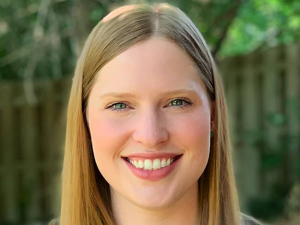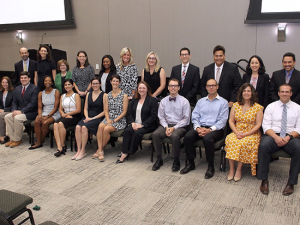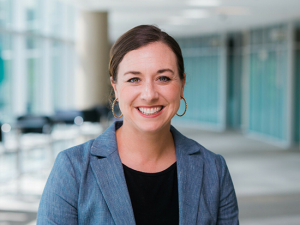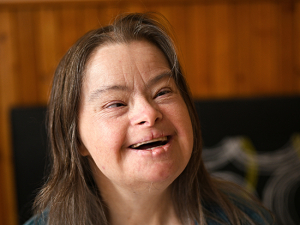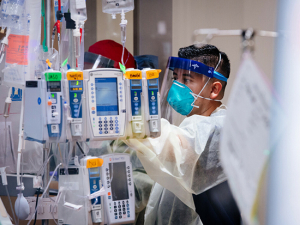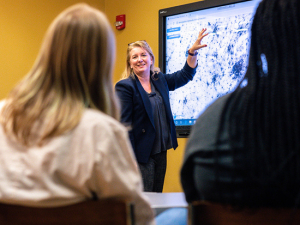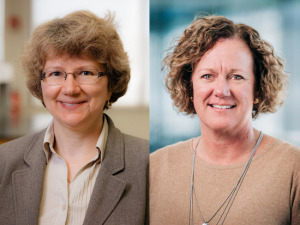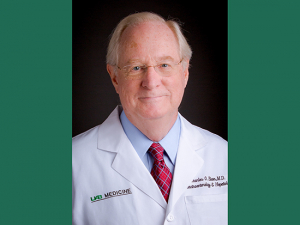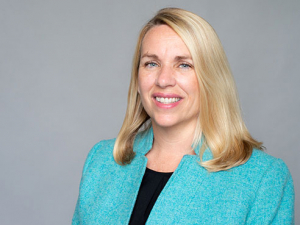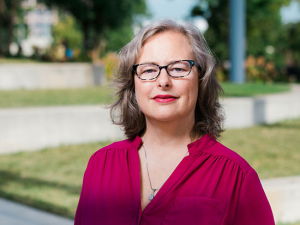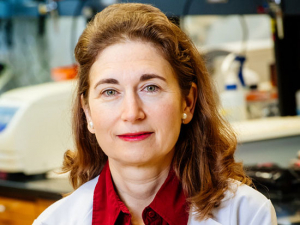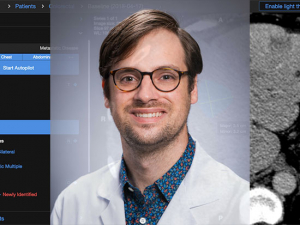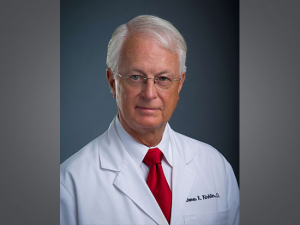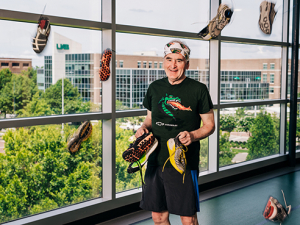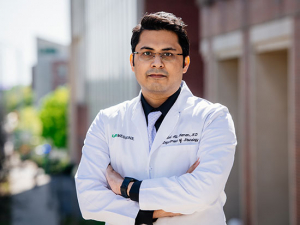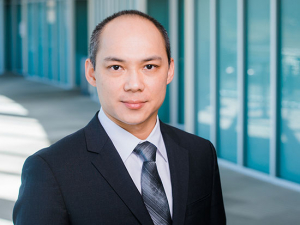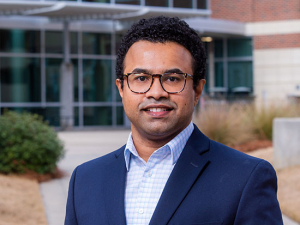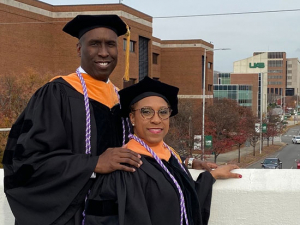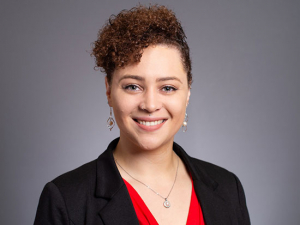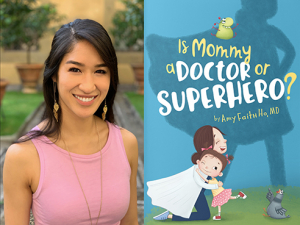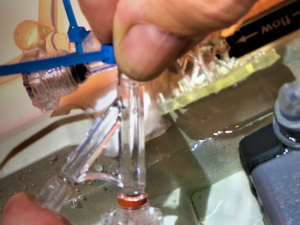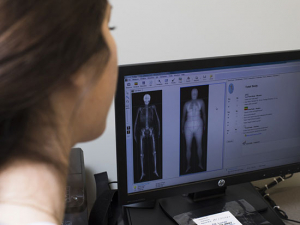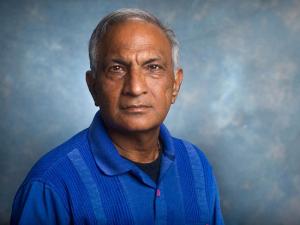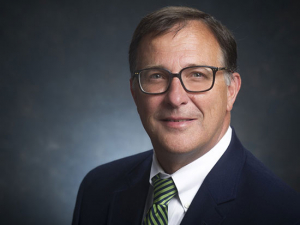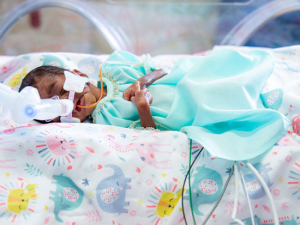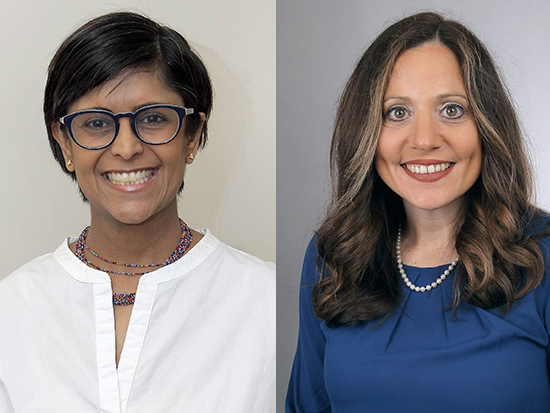 A partnership between pediatrician Snehal Khatri, M.D. (left), and program director Betsy Hopson (right) will focus on care for patients with Down syndrome across the lifespan, including addressing palliative and memory challenges. The unique approach was made possible through an HSF-GEF grant.Not very long ago, in the early 1980s, people with Down syndrome were not expected to live past 25. Today that number is up to 60 years old. But the extra years come with questions that few doctors or parents know how to answer.
A partnership between pediatrician Snehal Khatri, M.D. (left), and program director Betsy Hopson (right) will focus on care for patients with Down syndrome across the lifespan, including addressing palliative and memory challenges. The unique approach was made possible through an HSF-GEF grant.Not very long ago, in the early 1980s, people with Down syndrome were not expected to live past 25. Today that number is up to 60 years old. But the extra years come with questions that few doctors or parents know how to answer.
For instance, many of the relatively small number of people with Down syndrome who have lived to age 40 have developed dementia and other Alzheimer’s-like symptoms by then. But the medications doctors use to treat Alzheimer’s are not approved for people this young.
Applications window opens May 1 for 2024 HSF-GEF Awards
This site will be open May 1 through 4 p.m. June 28 for applications.
“We hear from parents that this is the thing they worry about the most,” said Snehal Khatri, M.D., associate professor in the Division of Developmental and Behavioral Pediatrics, and medical director of UAB Sparks Pediatrics. With a grant from UAB’s HSF-GEF program, Khatri and Betsy Hopson, director of the UAB Staging Transition for Every Patient Program in the Division of General Internal Medicine, will create a new clinic to focus on care for people with Down syndrome across the lifespan.
According to the National Institute on Aging, dementia will affect 50 percent or more of people with Down syndrome as they age, “and nothing existed for them,” Hopson said. “We are adopting a lifespan model, to be able to say to patients and parents, ‘this is where we know that you are going; this is the trajectory.’” Hopson and Khatri will be able to say to families, “we have a dedicated program that knows everything that will happen to your child and knows who the adult provider is to contact as they age,” Hopson said. “We are excited to build the entire lifespan program, but addressing the palliative and memory challenges will really make us unique to anywhere in the country.”
According to the National Institute on Aging, dementia will affect 50 percent or more of people with Down syndrome as they age, “and nothing existed for them,” Hopson said.
The clinic traces its origins to a conversation that Khatri had with Mitch Cohen, M.D., chair of the Department of Pediatrics. Cohen asked Khatri, who is a member of the board of directors of Down Syndrome of Alabama, to look into reopening a Down syndrome clinic that had operated at Children’s of Alabama until about a decade ago. “We asked the community if this is something they wanted,” Khatri said. “A lot of the feedback we had was related to the issues with transition between pediatric and adult clinics.”
“If you look across the health system, there is this gap that happens, which is true across many disciplines,” Hopson said. “Life changes are happening — they are leaving high school, trying to figure out what comes next, and right in the middle of that you have this transition in medical care, with brand-new doctors. If you look at the data, you really see how medical outcomes decline during this time.”
“It is a very different experience in the pediatric world and the adult world,” Khatri said. “Insurance changes. What is covered changes. So being thoughtful in planning for these changes early is extremely important.” Khatri was aware of Hopson’s work with the STEP Program, which creates “transition champions” in both the adult and pediatric divisions “to have a warm hand-off,” Hopson said.
“We are excited to build the entire lifespan program, but addressing the palliative and memory challenges will really make us unique to anywhere in the country.”
STEP was created in 2020 through an HSF-GEF grant awarded in 2019 to Hopson and Carlie Stein Somerville, M.D., associate professor in the Division of General Internal Medicine. “We have had a lot of success with STEP, and we are using that success for the infrastructure of this brand-new program,” Hopson said. “The adult Down syndrome piece is going to happen within STEP, where those partnerships [with various disciplines] will already exist. If a neurologist is needed, that neurologist will be there in the clinic. This new group of patients is really going to benefit from the partnerships and collaborations that have been formed.”
Even in the pediatrics realm, many physicians do not keep up with the latest guidelines for care, Khatri says. The American Academy of Pediatrics and the Down Syndrome Medical Interest Group publish guidelines from birth to age 21, including lab work, questions to ask and other milestones to look for as patients age. But “you would be surprised at the number of primary care doctors who don’t know they exist,” Khatri said. “Having a dedicated clinic will improve adherence to medical guidelines for the pediatric patients.” Clinicians will be able to contact the clinic for additional support. “This will not be for everybody,” Khatri said. “It will be for families and physicians who need additional supportive or umbrella services.”
“For the vast majority of patients, we will work with their existing clinicians; it is co-management,” Hopson said. “We will help ensure that intervals are being followed, imaging that needs to take place is scheduled, so the local primary care doctor or pediatrician can focus on acute management. We are really holding the pieces together.”
"This will not be for everybody. It will be for families and physicians who need additional supportive or umbrella services.”
The clinic will be a collaboration not only across UAB Medicine and the Heersink School of Medicine, but across UAB’s other health schools. For example, clinicians often recommend physical therapy and occupational therapy; but when patients and families return to their communities, especially in rural Alabama, “a lot of that doesn’t exist,” Hopson said. “One of the creative things we wrote into the grant is to work with the School of Health Professions to create a curriculum of at-home therapy and potentially telemedicine, so we have a toolbox of therapy at home.”
The link between pediatric and adult services also means that good ideas can be quickly shared. “One of the things that has been successful at Children’s of Alabama is recognizing sensory needs and the development of sensory pathways” for patients with autism, Down syndrome and other intellectual disabilities, Hopson said. “What STEP has allowed us to do is to put teams and working groups together to determine what successful practices from pediatric care should or could be brought into the adult clinics. If we know that multidisciplinary clinics work well or that care coordination works well in pediatrics, we can adapt these ideas. When you think about it in terms of lifespan, what makes it work well from 0–18? Why was the family so comfortable? Let’s adopt those practices with the adult patients. And then we have insights such as when the adult providers say, ‘I see patients who are 21 and don’t know they can get pregnant.’ That calls for education on the pediatric side. There is a two-way education stream.”
The lifespan model has potential beyond Down syndrome, Khatri points out. “There are so many conditions that we see in pediatrics that don’t have a good home: autism, dual diagnoses,” she said. “Is this a framework for other conditions that also cross over from the pediatric to the adult world? We aim to find out.”
How do the HSF-GEF awards advance UAB? Faculty explain their projects:
How the HSF’s General Endowment Fund awards help UAB compete on a national stage
Advancing faculty careers through the UAB Academy of Health Professions Educators
Building immuno-imaging at UAB through specialized technology
Turning a pilot project into the standard of care
Making the leap from one hospital to another through UAB’s STEP Program
Building a health system that can learn calls for “team science to the max”
Using geographic information systems in patient-oriented research


